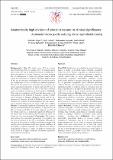Files in this item
Anatomically high division of sciatic nerve and its clinical significance
Item metadata
| dc.contributor.author | Kapor, Slobodan | |
| dc.contributor.author | Puskas, Laslo | |
| dc.contributor.author | Vojvodic, Aleksandar | |
| dc.contributor.author | Malis, Milos | |
| dc.contributor.author | Bjelogrlic, Predrag | |
| dc.contributor.author | Cezayirli, Enis | |
| dc.contributor.author | Chisholm, Fraser | |
| dc.contributor.author | Aksic, Milan | |
| dc.contributor.author | Filipovic, Branislav | |
| dc.date.accessioned | 2021-11-17T12:30:08Z | |
| dc.date.available | 2021-11-17T12:30:08Z | |
| dc.date.issued | 2021-03-05 | |
| dc.identifier | 276713495 | |
| dc.identifier | 4e2a8c86-e612-42de-bfd7-d6f8d13679ef | |
| dc.identifier | 85119908667 | |
| dc.identifier | 000715905000006 | |
| dc.identifier.citation | Kapor , S , Puskas , L , Vojvodic , A , Malis , M , Bjelogrlic , P , Cezayirli , E , Chisholm , F , Aksic , M & Filipovic , B 2021 , ' Anatomically high division of sciatic nerve and its clinical significance ' , Vojnosanitetski pregled , vol. 78 , no. 10 , pp. 1060-1064 . https://doi.org/10.2298/vsp200113031k | en |
| dc.identifier.issn | 0042-8450 | |
| dc.identifier.other | Jisc: 50eba33402f84f35a070a626688ffe53 | |
| dc.identifier.other | ORCID: /0000-0003-3069-4130/work/103511139 | |
| dc.identifier.uri | https://hdl.handle.net/10023/24347 | |
| dc.description | Funding: This study was supported by the Ministry of Education, Science and Technological Development of the Republic of Serbia (Grant III41020). | en |
| dc.description.abstract | Background / Aim The sciatic nerve (SN) is a mixed nerve formed in pelvis by joining of L4 - S3 anterior spinal nerve roots. SN can be under the pressure in different regions throughout its course. However, the most frequent site of impingement is under the piriformis muscle which causes the occurrence of piriformis syndrome. High division of SN has its relevance considering the fact that it leads to the compression of nerve resulting in piriformis syndrome. The aim of this study was to determine the connection between anatomical parameters of pelvis and high division of SN, which is considered to be one of the most common causes of piriformis syndrome in both genders. Methods This study was conducted on 28 formalin fixed cadavers of both genders at the Institute of Anatomy, Faculty of Medicine, University of Belgrade (Belgrade, Serbia) and the Department of Anatomy, School of Medicine, University of St Andrews (St Andrews, United Kingdom). For the measuring of required dimensions, we used a ruler and a caliper. Results A statistically significant difference in the values of bispinal and bituberal lines was observed. A high division of SN was found on 58.33% of the male cadavers and 80% of the female cadavers. A statistically significant difference in the mean value of the bituberal line between the male and female sex was also recognised. Conclusion The connection between the anatomical parameters of the pelvis and the level of division of the SN is confirmed. Although on the basis of the results it could be assumed that people with smaller pelvic dimensions would have greater likelihood of developing a piriformis syndrome, the other factors, such as biomechanics related to a wider 'Q angle' in women that could result in a higher incidence of piriformis syndrome, should also be considered. | |
| dc.format.extent | 5 | |
| dc.format.extent | 581058 | |
| dc.language.iso | eng | |
| dc.relation.ispartof | Vojnosanitetski pregled | en |
| dc.subject | Sex characteristics | en |
| dc.subject | Anatomy | en |
| dc.subject | Regional | en |
| dc.subject | Cadaver | en |
| dc.subject | Piriformis muscle syndrome | en |
| dc.subject | Sciatic nerve | en |
| dc.subject | QM Human anatomy | en |
| dc.subject | NDAS | en |
| dc.subject | MCC | en |
| dc.subject.lcc | QM | en |
| dc.title | Anatomically high division of sciatic nerve and its clinical significance | en |
| dc.type | Journal article | en |
| dc.contributor.institution | University of St Andrews. School of Medicine | en |
| dc.contributor.institution | University of St Andrews. Education Division | en |
| dc.identifier.doi | 10.2298/vsp200113031k | |
| dc.description.status | Peer reviewed | en |
This item appears in the following Collection(s)
Items in the St Andrews Research Repository are protected by copyright, with all rights reserved, unless otherwise indicated.

